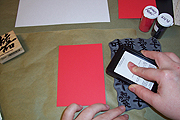 First, you need the right ink. For many new stampers, plain old pigment ink will do, since it’s probably already in your stash of supplies. My pigment ink of choice is Brilliance, but other suitable pads include Crafters, PetalPoints and VersaColor. Pigment inks are pigment mixed with a binder, which helps the emobssing powder stick to the surface. They also have a longer drying time than solvent or dye inks, which is important. Another choice is an embossing inkpad, which usually contains a binder, or a binder mixed with a tiny bit of pigment to create a pale tint. These pads are great for folks who do a lot of embossing, and I’ll address them towards the end of this article.
First, you need the right ink. For many new stampers, plain old pigment ink will do, since it’s probably already in your stash of supplies. My pigment ink of choice is Brilliance, but other suitable pads include Crafters, PetalPoints and VersaColor. Pigment inks are pigment mixed with a binder, which helps the emobssing powder stick to the surface. They also have a longer drying time than solvent or dye inks, which is important. Another choice is an embossing inkpad, which usually contains a binder, or a binder mixed with a tiny bit of pigment to create a pale tint. These pads are great for folks who do a lot of embossing, and I’ll address them towards the end of this article.
The next supply you’ll need is embossing powder. This is a thermographic powder made with a very fine resin that fuses when heated. There are dozens of brands and qualities out there, and each stamper has her favorite. If you’re new to embossing, just get a small container of very fine black powder to start. Eventually, you’ll grow your collection of colors and finishes the same way you grow your inkpad collection.
Last, but not least, you’ll need a heat tool. Most rubber stamp and paper craft oriented stores will carry one for around twenty dollars. Trust me when I say you cannot emboss without one—your blow dryer won’t work, because it doesn’t get nearly hot enough to melt the resin.
 Let’s start with this simple card. I used black cardstock, red cardstock, and a piece of asian text paper. My embossing is black characters on the red cardstock, and a red character on the text paper.
Let’s start with this simple card. I used black cardstock, red cardstock, and a piece of asian text paper. My embossing is black characters on the red cardstock, and a red character on the text paper.






I should probably say a few words about stamps before we move on. Embossing is best done with stamps that have larger solid areas and broad features. Photorealistic stamps with lots of detail aren’t really the best stamps for embossing, because when the resin melts, some of the detail is lost. This is best illustrated by trying it yourself—just ink up your favorite detailed stamp, stamp it on a piece of scrap paper, and emboss it. Very often, the result will be disappointing.

 This card was made using the same cardstock and text pages with a glittery gold embossing powder. I don’t usually enjoy working with glittered powders, because the little glitter flecks get everywhere, no matter how neat I am, so most of my powders are matte solids. I’ll have to use some embossing ink for this project, because I don’t have any gold pigment ink. Although it’s not required that inks and powders match, there’s sometimes a little bleed through of ink color when the resin melts, and there are also sometimes areas that dry too quickly to catch any powder, leaving the ink bare. For this card, I’d prefer not to see any black pigment ink.
This card was made using the same cardstock and text pages with a glittery gold embossing powder. I don’t usually enjoy working with glittered powders, because the little glitter flecks get everywhere, no matter how neat I am, so most of my powders are matte solids. I’ll have to use some embossing ink for this project, because I don’t have any gold pigment ink. Although it’s not required that inks and powders match, there’s sometimes a little bleed through of ink color when the resin melts, and there are also sometimes areas that dry too quickly to catch any powder, leaving the ink bare. For this card, I’d prefer not to see any black pigment ink.



Heating images stamped with embossing powder is the same as with inks—just heat the surface evenly, making sure all the powder dissolves.




